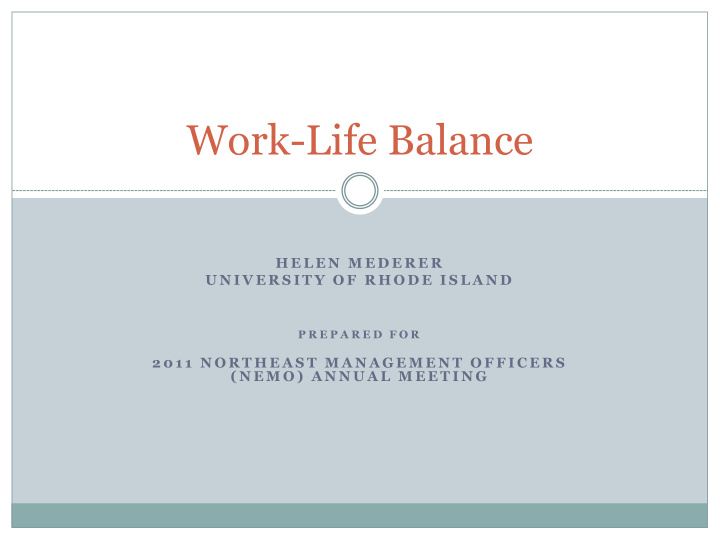



Work-Life Balance H E L E N M E D E R E R U N I V E R S I T Y O F R H O D E I S L A N D P R E P A R E D F O R 2 0 1 1 N O R T H E A S T M A N A G E M E N T O F F I C E R S ( N E M O ) A N N U A L M E E T I N G
A Personal Problem or a Social Issue? Impossible in our personal lives because of imbalance in culture policy economy
Work and Family as Social Institutions Work: produces goods and services necessary for survival Families: Bear and raise the next generation of workers; caregiving
Cultural Attitudes Very aware that families need work to survive Less aware that work needs families to survive
Families are “work - friendly” The “ideal family”: a family with at least one worker 70% of U.S. households have all adults in the labor force More than half of all mothers with children under 1 year of age are in the labor force; 71% with children under 18 48% of the workforce is female Average number of hours worked has increased Boundaries between home and work are blurred: 1 in 3 employees is in contact with work once a week or more outside normal work hours (FWI, 2004)
Mothers’ Labor Force Participation: U.S.
Work Intrudes into Family . . .
Work is not family-friendly The “ideal worker” is defined as one without any family responsibilities Available to work 24-7 Availability supported by a “family specialist”— a full-time homemaker Expected to conduct professional life without any interference from other life priorities A male model from the mid-20 th century: the ideal worker is a man
Work-Centrism
Cultural Contradiction Ideal Family: a family with at least one worker versus Ideal Worker: a worker with no family Not a personal problem, but incompatible social institutions
Parents’ Time with Children
Parents’ Time with Children
Perceptions of Time Famine
Work- Family Conflict: Not a “Women’s Issue”
Work Becomes Home and Home Becomes Work
Returning to Work after Childbirth
Predictors of Work-Life Conflict: Mothers
Predictors of Work-Life Conflict: Fathers
Frequency of Elder Care
Extent of Elder Care
Work-Life Conflict and Elder Care
What Caregivers for Elders Wish For
Access to Flex Time
Perceptions of Supervisor Support
Control Over Work Schedule
Time Off After Childbirth
Access to Paid Family Leave
Parental Leave Comparisons
Living up to the Ideal Worker Norm
Living up to the Ideal Worker Norm
Effects of work-life stress
Why flexibility in a weak economy? Clear and compelling: A “business case” for flexibility
Benefits of Workplace Flexibility: Job Engagement
Benefits of Flexibility: Job Satisfaction
Benefits of Flexibility: Retention
Benefits of Flexibility: Health
Benefits of Flexibility: Mental Health
National Dialogue on Workplace Flexibility EXECUTIVE OFFICE OF THE PRESIDENT COUNCIL OF ECONOMIC ADVISERS WORK-LIFE BALANCE AND THE ECONOMICS OF WORKPLACE FLEXIBILITY MARCH 2010
National Science Foundation September 2011
Work-Life Professional Association
URI’s Work-Life Committee
International Nonprofit Organizations
New Business Opportunities
New Legal Strategy
Summary Work and Families: essential social institutions. Culture has privileged work; economy has stretched families; much work-life stress Men want more balance Marriage demands more equality today Work-life balance leads to sustainability.
Recommend
More recommend